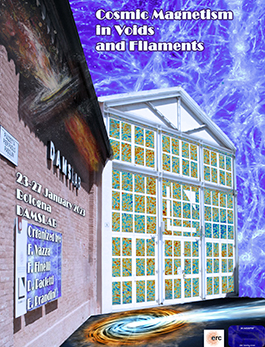Conveners
Tuesday
- Kerstin Kunze (University of Salamanca)
Tuesday
- Franco Vazza (Istituto Nazionale di Astrofisica (INAF))
The origin of magnetic fields in the Universe is an open problem in cosmology. One of the most promising ways to probe intergalactic magnetic fields (IGMFs) is using gamma rays produced in electromagnetic cascades initiated by high-energy gamma rays in the intergalactic space. Because the charged component of the cascade is sensitive to intervening magnetic fields, it is possible to probe...
A new kind of density perturbations can be sourced by primordial magnetic fields (PMF) via their Lorentz force in the early Universe, particularly around the epoch of recombination (z~1100). PMF-induced density perturbations are expected to be quite distinct from standard adiabatic perturbations. We present 3D MHD simulations to follow the growth and characteristics of these density...
I will present a review of the effects that a primordial magnetic field present during the inflationary epoch can have on a warm inflation scenario, both on the effective potential and on the inflaton decay process.
The origin of the ubiquitous cosmic magnetic fields remains one of the big open questions in astrophysics, with many different seeding mechanisms being proposed over the years. Recently, it has been shown that magnetic fields can be created in the ionizing photon shadow behind overdense regions around the first galaxies. I will present the first ever cosmological simulations of such seeding...
The abstract is splitted into two paragraphs. The first paragraph is a
general description, while the second paragraph gives the description
of the primordial magnetism aspects. If you think that the abstract is
too long, please use just the first paragraph. It is completely up to
you.
Abstract:
The detection of the relic magnetic fields through cosmological or
astrophysical...
Radio-loud AGN can be observed throughout the majority of the history of the Universe and are thus excellent beacons for measuring the properties of the cosmic web and their evolution. In this talk, I will highlight recent results from the Low Frequency Array (LOFAR) telescope that use the effect of Faraday rotation to measure the evolution of the magnetic field strength in the filaments and...
Primordial Magnetic Fields (PMFs), being good candidates for explaining the large-scale magnetisation of our Universe, evolve in a distinguishable fashion across different cosmological epochs. Their post-recombination structure and coherence scale depend on (i) details of the particular magnetogenesis model and (ii) evolutionary trends in the pre-recombination Universe. Inflation and...
We present a part of the Simulating the LOcal Web (SLOW) project consisting of a cosmological non-radiative MHD simulation of a 500 Mpc h^-1 box including the spectral Cosmic Ray (CR) model presented in Böss et. al. (2022). I will briefly introduce the solver and show its application to predicting synchrotron emission from cosmic web filaments and accretion shocks around clusters, as well...

